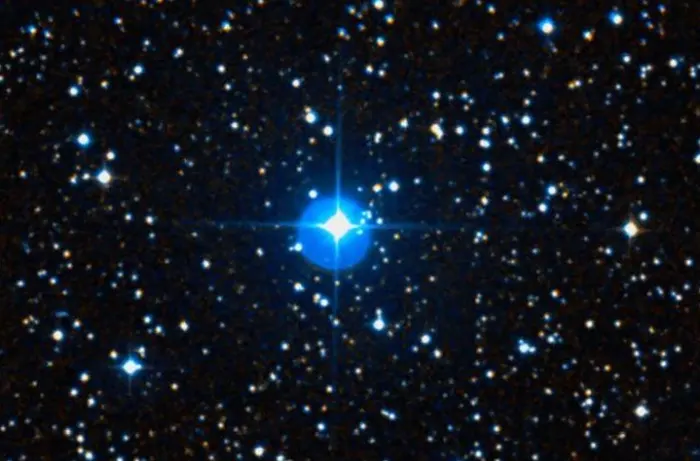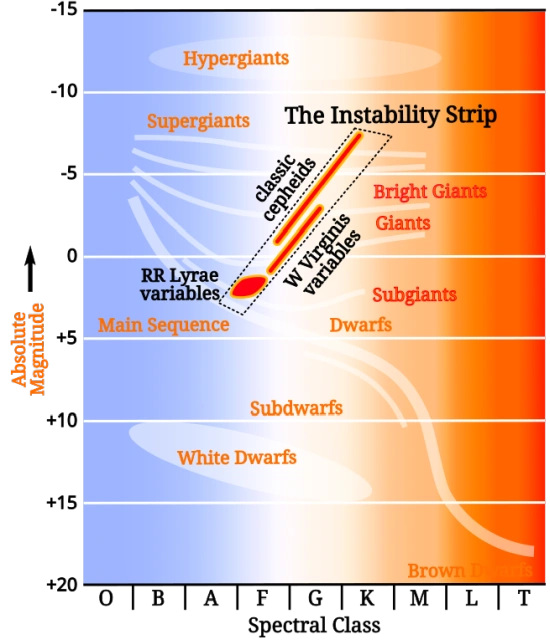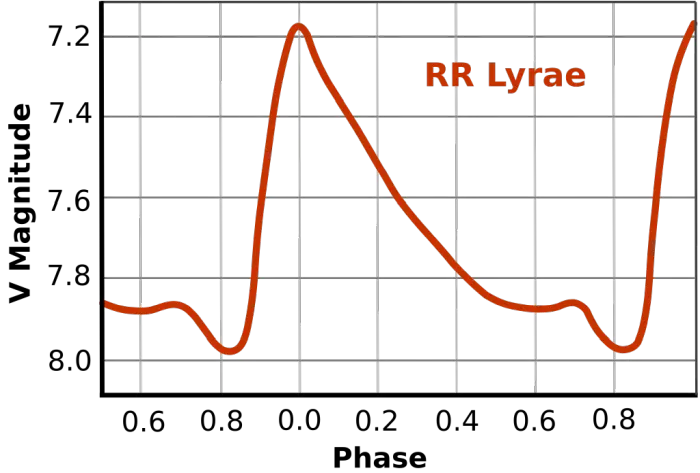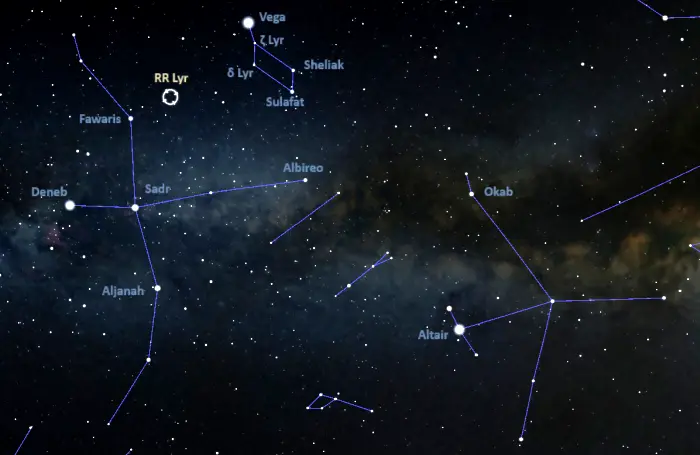RR Lyrae is a variable giant star located approximately 900 light years away in the constellation Lyra. With an apparent magnitude that varies from 7.06 to 8.12, the star is invisible to the unaided eye. It serves as the prototype for a class of variable stars known as the RR Lyrae variables.
Star type
RR Lyrae is a yellow giant of the spectral type A7III – F8III. It has a mass of 0.65 solar masses and a radius of 5.1 to 5.6 solar radii. With a surface temperature 6,125 K, it is around 49 times more luminous than the Sun.
RR Lyrae is a pulsating star that has already passed through the red giant stage even though it has only 65% of the Sun’s mass. This indicates that the star is very old. It is currently on the horizontal branch (HB), fusing helium at its core. It is the prototype for a class of horizontal branch stars that vary in brightness due to pulsations.
RR Lyrae is a Population II star, an old star with an underabundance of elements heavier than hydrogen and helium. The low metallicity indicates that the star formed when the universe was much younger and is part of a much older galactic population than the Sun.
The outer envelope of RR Lyrae shows regular radial pulsations, which are causing the star’s visual brightness to oscillate between magnitude 7.06 and 8.12 over a period of 0.567 days (13 hours and 36 minutes). As the star pulsates, its radius varies between 5.1 and 5.6 solar radii.
The pulsations occur when radiation is partly blocked from escaping the star. As a result, there is an increase in temperature and pressure that makes the star expand. Gravity then makes it contract again and the pulsation cycle begins again.
The distance to RR Lyrae was measured using astrometry with the Hubble Space Telescope (HST) in 2001. A team of astronomers led by G. Fritz Benedict of the McDonald Observatory, University of Texas, Austin, used Hubble’s fine guidance sensor to determine a distance of 855 light years (262 pc) with a 5 percent margin of error. By combining the measurements with data obtained by the Hipparcos satellite, astronomers found a distance of 841 ly (258 pc).
The star orbits the centre of the Milky Way close to the galactic plane. The trajectory of the orbit takes it within 680 light years of the plane.
RR Lyrae has a highly eccentric orbit. As it orbits through the Milky Way, it comes within 6,800 light-years of the Galactic centre and gets as far away from it at 59,900 light-years.

RR Lyrae, image credit: ESO/Digitized Sky Survey 2 (CC BY 4.0)
RR Lyrae variables
RR Lyrae is the brightest example of a class of variable stars known as the RR Lyrae variables. The star serves as the class prototype. RR Lyrae stars are A- or F-type pulsating stars with around half the Sun’s mass that show variations in brightness over short periods, typically less than a day. These stars vary in brightness by 0.2 – 2 magnitudes, which corresponds to a change of luminosity from 20% to more than 500%.
RR Lyrae stars are pulsating giants on the horizontal branch (HB). These stars have shed a lot of their mass while on the red giant branch (RGB) and are producing energy by the thermonuclear fusion of helium.
RR Lyrae variables are found at the instability strip, a region of the Hertzsprung-Russell diagram populated by several classes of pulsating variable stars. RR Lyrae stars lie in the region where the instability strip intersects the horizontal branch stage of evolution. The more massive Cepheid variables lie where it crosses the supergiant stage, Delta Scuti stars lie near the main sequence, and ZZ Ceti stars lie where the instability strip crosses the white dwarf sequence. RR Lyrae variables are less luminous than the Cepheids, but brighter than Delta Scuti variables.

HR diagram with instability strip added, image credit: Wikimedia Commons/Rursus (CC BY-SA 3.0)
RR Lyrae variables are used as standard candles to measure distances to deep sky objects. Like the more luminous Cepheid variables, these stars have a known luminosity. By comparing their luminosity to their observed brightness, astronomers can determine distances to galactic objects using the inverse-square law. However, unlike the Cepheids, RR Lyrae stars do not follow a strict period-luminosity relation at visual wavelengths, but they do in the infrared K-band. They have much lower luminosities than the more massive Cepheid variables, which are typically supergiants.
While these stars are too dim to be used for distance measurements to most extragalactic objects, astronomers have identified several candidate RR Lyrae variables in the Andromeda Galaxy using the Hubble Space Telescope. A team led by G. Clementini, National Institute for Astrophysics – Astrophysics and Space Science Observatory of Bologna, Italy, reported the discovery of RR Lyrae candidates in four globular clusters of M31, catalogued as G11, G33, G64, and G322, in 2021. RR Lyrae stars were previously detected in Andromeda’s halo by Pritchet and Van Den Bergh using the Canada-France-Hawaii Telescope (CFHT) in the 1980s.
RR Lyrae variables and novae are used to measure distances to elliptical galaxies, which do not typically contain the young, massive Cepheids. Elliptical galaxies do not have large-scale star formation and mostly consist of older, low-mass stars. For this reason, astronomers use standard candles with origins in an older stellar population to determine distances to these objects.
RR Lyrae variables are old stars that make up over 80% of all known variables in globular clusters. They are sometimes called cluster Cepheids because they can be used as distance indicators to these objects. The first RR Lyrae variable discovered outside a star cluster was U Leporis in the constellation Lepus, discovered by the Dutch astronomer Jacobus Kapteyn in 1890.
Other stars in this class include SW Andromedae in the constellation Andromeda, TU Ursae Majoris in Ursa Major, and X Arietis in Aries.
Facts
The variability of RR Lyrae was discovered by Scottish astronomer Williamina Fleming on a photographic plate taken on July 13, 1899, at the Harvard College Observatory. Edward Charles Pickering, who was director at Harvard College at the time, reported the discovery in The Astrophysical Journal in 1901. RR Lyrae was one of the 64 new variable stars detected using time-series photometry. Pickering noted that these stars were “indistinguishable from cluster-type variables.”
RR Lyrae was not the first RR Lyrae variable to be discovered. U Leporis in the constellation Lepus and S Arae in Ara, as well as cluster variables discovered by Fleming in 1893, were reported first. However, as the brightest star in this class, RR Lyrae serves as the class prototype.
RR Lyrae variables became recognized as their own class, different from classical Cepheids, between 1910 and the 1930s, on account of their different chemical composition and shorter periods of variation.
In 1916, American astronomer Harlow Shapley reported that the times of maximum, amplitude and shape of the star’s light curve varied with a period of about 40 days. Shapley described the long-period modulation of the star’s pulsation strength and/or phase, a phenomenon now known as the Blazhko effect. The effect causes a variable star’s light curve to change from one cycle to another. Only a subset of RR Lyrae variables – those of type RRab – show the effect. RR Lyrae has a Blazhko period of 39.1 ± 0.3 days.
In 2014, a study led by M. Chadid at the Côte d’Azur Observatory proposed that the effect has a physical origin. By observing the RR Lyrae variable S Arae in the constellation Ara, the astronomers detected multi-shocks propagating through the star’s atmosphere. They proposed that the origin of the Blazhko effect is a dynamical interaction between a multi-shock structure and an outflowing wind in a coronal structure. The study was published in The Astronomical Journal.

This is a representative, hand-drawn illustration of the typical light curve for RR Lyrae. The light curve varies slightly from cycle to cycle because of the Blazhko effect. Image credit: Wikimedia Commons/RJ Hall (CC BY-SA 3.0)
Name
RR Lyrae does not have a proper name formally approved by the International Astronomical Union (IAU). It is commonly referred to by its variable star designation RR Lyrae. The star is catalogued as HD 182989 in the Henry Draper Catalogue, HIP 95497 in the Hipparcos Catalogue, and SAO 48421 in the Smithsonian Astrophysical Observatory Star Catalog.
Location
RR Lyrae lies in the eastern part of Lyra, between the constellation figures of Lyra and Cygnus (the Swan), close to the Swan’s wing. The star appears along the imaginary line extended from Fawaris (Delta Cygni) to Zeta Lyrae. It can be seen in binoculars and small telescopes.
At declination +42° 47’, RR Lyrae is best seen from the northern hemisphere. It never rises for observers south of the latitude 47° S.

RR Lyrae location, image: Stellarium
Constellation
RR Lyrae is located in the northern constellation of Lyra. Representing the lyre of the Greek mythical musician and poet Orpheus, Lyra is one of the Greek constellations catalogued by the Greco-Roman astronomer Claudius Ptolemy in his Almagest in the 2nd century AD.
Lyra is the 52nd largest constellation in the sky, stretching across only 286 square degrees. It appears in the region between the larger Cygnus (the Swan) and Hercules.
Vega, the brightest star in Lyra, is a white main sequence star that shines at magnitude 0.026 from a distance of only 25.04 light-years. It is the second brightest star in the northern celestial hemisphere, after Arcturus in Boötes, and the fifth brightest star in the night sky. The bright star appears next to a small parallelogram asterism that outlines the pattern of the celestial Lyre. Vega is the only star in Lyra brighter than magnitude 3.0.
Other notable stars in the constellation include the hot blue giant Sulafat (Gamma Lyrae), the red bright giant Delta2 Lyrae, the orange giant Kappa Lyrae, the variable stars Beta Lyrae (Sheliak) and R Lyrae, the spectroscopic binary star Zeta1 Lyrae, the multiple star system Epsilon Lyrae (the Double Double), the visual double star Delta Lyrae, and the Cepheid variable V473 Lyrae. The constellation also contains the yellow dwarfs Kepler-209, which hosts a system of two extrasolar planets, and Kepler-20 with five or six planets, and the orange dwarfs Kepler-62, Kepler-444 and Kepler-102 with five exoplanets each.

Lyra constellation map by IAU and Sky&Telescope magazine (Roger Sinnott & Rick Fienberg) (CC BY 3.0)
Deep sky objects in Lyra include the planetary nebulae Messier 57 (the Ring Nebula) and Abell 46, the open star cluster NGC 6791, the globular cluster Messier 56, the irregular galaxy NGC 6745, the spiral galaxies NGC 6646 and IC 1296, and the elliptical galaxy NGC 6685.
The best time of the year to observe the stars and deep sky objects in Lyra is during the month of August, when the constellation appears high above the horizon in the early evening. The entire constellation is visible from locations north of the latitude 40° S.
The 10 brightest stars in Lyra are Vega (Alpha Lyrae, mag. 0.026), Sulafat (Gamma Lyrae, mag. 3.261), Sheliak (Beta Lyrae A, mag. 3.52), R Lyrae (mag. 4.00), Delta2 Lyrae (mag. 4.22), Kappa Lyrae (mag. 4.35), Zeta1 Lyrae (mag. 4.34), Theta Lyrae (mag. 4.347), Aladfar (Eta Lyrae, mag. 4.40), and Epsilon2 Lyrae A (mag. 4.59).
RR Lyrae
| Spectral class | A7III – F8III |
| Variable type | RR Lyrae |
| U-B colour index | +0.172 |
| B-V colour index | +0.181 |
| Apparent magnitude | 7.06 – 8.12 |
| Absolute magnitude | 0.600 ± 0.126 |
| Distance | 900 ± 60 light-years (270 ± 20 parsecs) |
| Parallax | 3.9849 ± 0.265 mas/yr |
| Radial velocity | −78.0694 ± 0.0919 km/s |
| Proper motion | RA: −109.599 ± 0.029 mas/yr |
| Dec.: −195.851 ± 0.032 mas/yr | |
| Mass | 0.65 M☉ |
| Luminosity | 49 ± 5 L☉ |
| Radius | 5.1 – 5.6 R☉ |
| Temperature | 6,125 ± 50 K |
| Metallicity | -1.16 dex |
| Surface gravity | 2.4 ± 0.2 cgs |
| Constellation | Lyra |
| Right ascension | 19h 25m 27.9129605304s |
| Declination | +42° 47′ 03.693258204″ |
| Names and designations | RR Lyrae, RR Lyr, HD 182989, HIP 95497, SAO 48421, LTT 15677, NLTT 47799, BD+42°3338, AG+42 1698, GC 26836, GCRV 11873, PPM 58291, PLX 4550.00, SKY# 36151, TD1 24704, KIC 7198959, LSPM J1925+4247, SV* HV 180, NSVS 5543125, GEN# +1.00182989, GSC 03142-00494, TIC 159717514, AN 34.1901, USNO 886, USNO-B1.0 1327-00425262, GAT 791, G 125-7, uvby98 100182989, ASCC 425414, WEB 16701, AP J19252793+4247040, 2MASS J19252793+4247040, TYC 3142-494-1, Gaia DR2 2125982599341232896, Gaia DR3 2125982599343482624 |